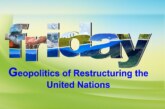
Dr. Arvind Kumar*
The curtains have fallen on COP30 in Belém, and the Amazon rainforest that hosted this monumental gathering now stands as a silent witness to what was promised, what was partially delivered, and more importantly what remains unfinished on humanity’s urgent journey toward climate justice. As the world reflects on the 30th UN Climate Change Conference, which concluded yesterday we find ourselves navigating a labyrinth of contradictions: significant momentum alongside structural paralysis, genuine action commitments paired with diplomatic hedging, and commitments to equity repeatedly undermined by geopolitical calculations.
Brazilian President Luiz Inácio Lula da Silva declared COP30 the “COP of truth,” and that truth is stark: scientific consensus indicates that a temporary overshoot beyond the 1.5°C limit is now likely as early as the 2030s. This urgency framed UN Climate Change Executive Secretary Simon Stiell’s opening appeal for alignment between negotiation rooms and real-world impacts, reminding delegates that the process is ultimately about people already bearing rising costs from climate-driven disasters to food and energy insecurity. Yet this people-centered vision collided with the familiar machinery of consensus diplomacy, where the powerful voices of fossil fuel interests can overshadow the existential pleas of the world’s most vulnerable. It was within this tension that UN Secretary-General António Guterres delivered his uncompromising directive: the era of debate must end. Now is the time for implementation implementation, and implementation.
The Unfinished Business
The Global Climate Action Agenda emerged as COP30’s most ambitious architectural innovation, consolidating over 480 initiatives into 117 concrete delivery plans. This represents a seismic shift from the traditional COP model: moving beyond negotiated texts toward implementation frameworks. Energy grids, renewable capacity, forest finance, and agricultural transformation saw tangible commitments. A $1 trillion investment plan to triple renewable capacity by 2030 materializes not merely as aspiration but as mobilized capital. The adaptation finance machinery, once sluggish, accelerated the Loss and Damage Fund issued its first $250 million call within record-breaking timeframes. These are not abstract promises; they are the sinews of transformation beginning to tighten. Yet this Action Agenda, for all its structural innovation, revealed a troubling pattern.
The COP30 outcome, however, revealed fissures that no amount of diplomatic language could seamlessly close. The most glaring absence: a fossil fuel roadmap. After two weeks of negotiations, the final draft text omitted any reference to fossil fuels entirely, despite more than 80 countries representing a strategic capitulation to resistance mounted primarily by oil-producing nations. The forest roadmap similarly failed to materialize as a formal binding outcome, despite being hosted in the heart of the Amazon. While the Action Agenda showcased the Tropical Forests Forever Facility with $5.5 billion in initial capital, the lack of a formal negotiated pathway to halt and reverse deforestation by 2030 represents a failure to match ambition with accountability mechanisms that developing nations could point to when navigating domestic pressures.
Climate finance texts revealed another structural weakness. Developed countries resisted committing that such funds originate as public finance from their treasuries, preferring ambiguous language that could encompass private flows, multilateral development bank lending, and debt-for-climate swaps. The ambition gap persisted. NDCs submitted indicate only a 12% emissions reduction by 2035, far below the 43-60% reductions science demands. India, notably, was among countries still finalizing revised NDCs as COP30 concluded, a delay that disappointed observers hoping for enhanced commitments.
COP30 diverged by emphasizing implementation rather than endless new negotiation tracks, mobilizing major multi-stakeholder initiatives including the $148-billion-per-year Green Grids Initiative, large-scale action on sustainable fuels, and regenerative agriculture programs spanning 110 countries. However, this shift toward voluntary implementation paradoxically weakened the negotiation arena: as climate action moved outside formal frameworks into bilateral and private-led platforms, states faced reduced pressure to compromise on contentious issues like fossil fuels and adaptation finance signaling a structural shift from binding multilateralism to flexible voluntarism.
India’s interventions at COP30 advanced a rare and uncompromising diplomatic philosophy principles over consensus. Aligning with the BASIC group and Like-Minded Developing Countries, India shifted the debate from merely “how much to cut emissions” to “who bears historical responsibility and must finance the transition.” Union Environment Minister Sh. Bhupender Yadav underscored India’s; strong record a 36% reduction in emission intensity since 2005, surpassing Paris commitments, and over 50% electricity from non-fossil sources, achieving its 2030 target five years early while identifying inadequate climate finance as the key barrier to global ambition. India also warned against unilateral trade measures like the EU’s CBAM, asserting they violate the principle of common but differentiated responsibilities, and called for equity-driven institutional mechanisms for a just transition, stressing that climate action without justice risks reinforcing global inequality.
Call for Action?
COP30 underscored that consensus-driven multilateralism, while inclusive, is no longer delivering the speed or scale demanded by climate science requiring structural reimagining rather than incremental adjustment. The Global Implementation Accelerator must evolve into a system of real accountability, with independent verification mechanisms to measure whether voluntary pledges translate into tangible mitigation and adaptation outcomes. Structural inequities in decision-making also demand reform: equal voting power for vulnerable small island states and fossil fuel exporters renders climate-just decisions mathematically unattainable, calling for weighted representation tied to vulnerability and historical responsibility. Finance architecture likewise requires overhaul $300 billion annually by 2035 remains inadequate when adaptation needs alone exceed $310 billion, and new instruments such as global carbon taxes, windfall taxes on fossil fuel profits, and debt-for-climate swaps should be pursued. Finally, India’s call for equity-anchored transitions must be institutionalized, ensuring Just Transition frameworks prioritize technology transfer without IP barriers and finance aligned with real needs rather than donor convenience.
COP30 exposed a defining paradox: celebrating the Paris Agreement’s progress while conceding that 1.5°C is likely to be exceeded. It highlighted that climate action without justice is insufficient Indigenous communities protecting most of the world’s biodiversity deserve real decision-making power, not symbolic funding allocations. COP31, to be hosted by Australia, must learn that implementation must be matched with ambition, and equity must move from rhetoric to structural reality. True climate leadership now requires recognizing that justice and global stability are indivisible, demanding a transformation of economic systems rooted in extractive growth toward models that protect people and the planet.
*Editor, Focus Global Reporter






